The Asus ROG Swift PG27UQ G-SYNC HDR Monitor Review: Gaming With All The Bells and Whistles
by Nate Oh on October 2, 2018 10:00 AM EST- Posted in
- Monitors
- Displays
- Asus
- NVIDIA
- G-Sync
- PG27UQ
- ROG Swift PG27UQ
- G-Sync HDR
SDR Color Modes: sRGB and Wide Gamut
Pre-calibration/calibration steps of the monitor is done with SpectraCal’s CalMAN 5 suite. For contrast and brightness, the X-Rite i1DisplayPro colorimeter is used, but for the actual color accuracy readings we use the X-Rite i1Pro spectrophotometer. Pre-calibration measurements were done at 200 nits for sRGB and Wide Gamut with Gamma set to 2.2.
The PG27UQ comes with two color modes for SDR input: 'sRGB' and 'Wide Gamut.' Advertised as DCI-P3 coverage, the actual 'Wide Gamut' sits somewhere between DCI-P3 and BT.2020 HDR, which is right in line with minimum coverages required by DisplayHDR 1000 and UHD Premium. That being the case, the setting isn't directly calibrated to a color gamut, as opposed to sRGB.
Out-of-the-box, the monitor defaults to 8 bits per color, which can be changed in NVIDIA Control Panel. Either way, sRGB accuracy is very good, as the monitor comes factory-calibrated. To note, 10bpc for the PG27UQ is with dithering (8bpc+FRC).
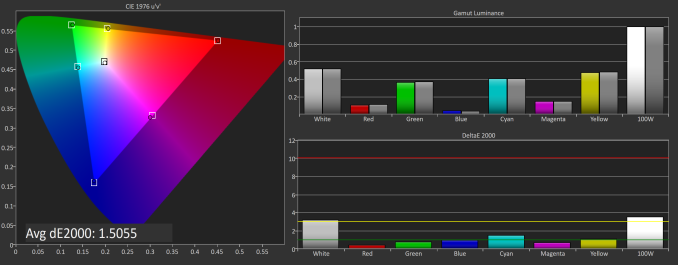
SpectraCal CalMAN sRGB color space for PG27UQ, with out-of-the-box default 8bpc (top) and default with 10bpc (bottom)
In 8bpc or 10bpc, average delta E is around 1.5, which corresponds with the included factory calibration result of 1.62; for reference, for color accuracy a dE below 1.0 is generally imperceptible and a dE below 3.0 is considered accurate.
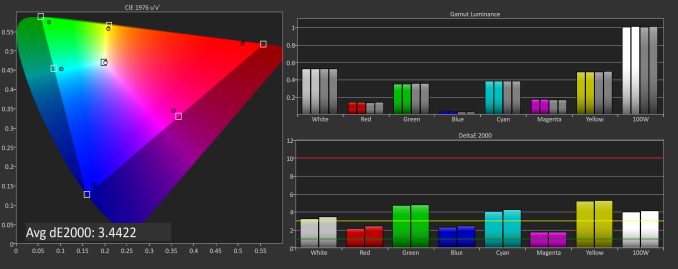 SpectraCal CalMAN DCI-P3 (above) and BT.2020 (below) color spaces for PG27UQ, on default settings with 10bpc and 'wide color gamut' enabled under SDR Input
SpectraCal CalMAN DCI-P3 (above) and BT.2020 (below) color spaces for PG27UQ, on default settings with 10bpc and 'wide color gamut' enabled under SDR Input
The 'wide gamut' options are not mapped to either DCI-P3 or BT.2020, sitting somewhere in between, but then again, it doesn't need to be as a professional or prosumer monitor would.
Grayscale and Saturation
Looking at color accuracy more throughly, we look at greyscale and saturation readings with respect to the sRGB gamut. The dips in gamma aren't perfect, and the whitepoints are a little on the warm side.
 SpectraCal CalMAN sRGB color space grayscales with out-of-the-box default 8bpc (top) and default with 10bpc (bottom)
SpectraCal CalMAN sRGB color space grayscales with out-of-the-box default 8bpc (top) and default with 10bpc (bottom)
The saturation numbers are better, and in fact the dE is around 1.5 to 1.4, which is impressive for a gaming monitor.
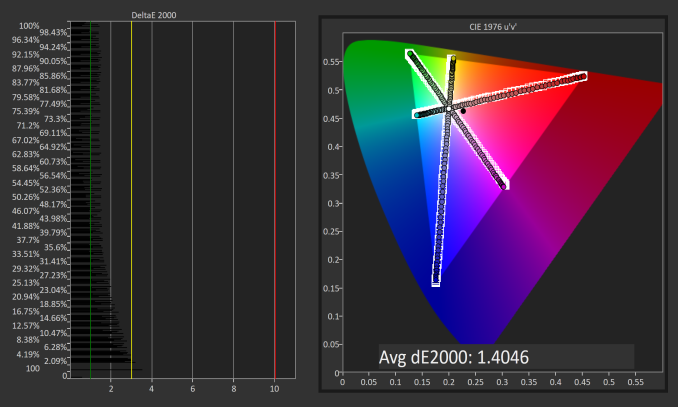 SpectraCal CalMAN sRGB color space saturation sweeps for PG27UQ, with out-of-the-box default 8bpc (top) and default with 10bpc (bottom)
SpectraCal CalMAN sRGB color space saturation sweeps for PG27UQ, with out-of-the-box default 8bpc (top) and default with 10bpc (bottom)
Gretag Macbeth (GMB) and Color Comparator
The last color accuracy test is the most thorough, and again the PG27UQ shines with dE of 1.53 and 1.63
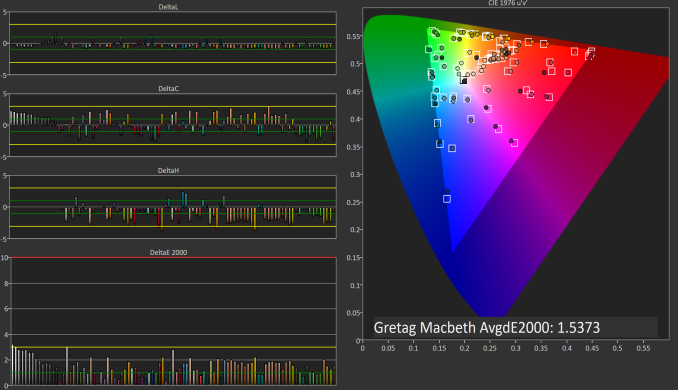 SpectraCal CalMAN sRGB color space GMB for PG27UQ, with out-of-the-box default 8bpc (top) and default with 10bpc (bottom)
SpectraCal CalMAN sRGB color space GMB for PG27UQ, with out-of-the-box default 8bpc (top) and default with 10bpc (bottom)
Considering that this monitor was not designed for professional use, it's very calibrated out-of-the-box for gamers, and there's no strong concern for calibration. If anything, users should just be sure to select 10bpc in the NVIDIA Control Panel, but even then most games use 8bpc anyhow.

 SpectraCal CalMAN sRGB relative color comparator graphs for PG27UQ, with out-of-the-box default 8bpc (top) and default with 10bpc (bottom). Each color column is split into halves; the top half is the PG27UQ's reproduction and the bottom half is the correct value
SpectraCal CalMAN sRGB relative color comparator graphs for PG27UQ, with out-of-the-box default 8bpc (top) and default with 10bpc (bottom). Each color column is split into halves; the top half is the PG27UQ's reproduction and the bottom half is the correct value


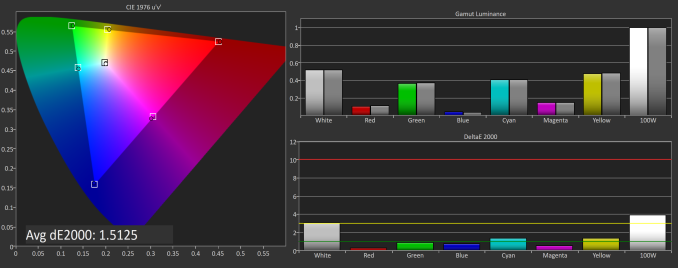
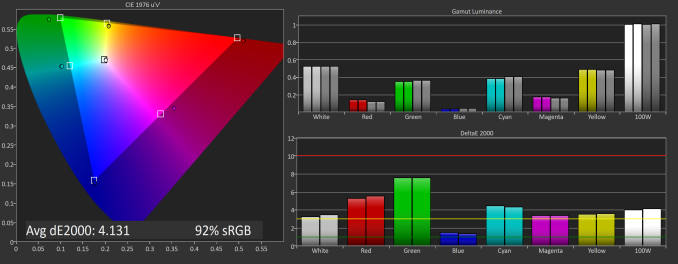
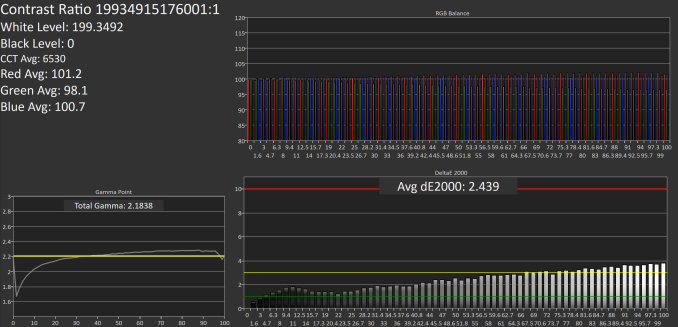
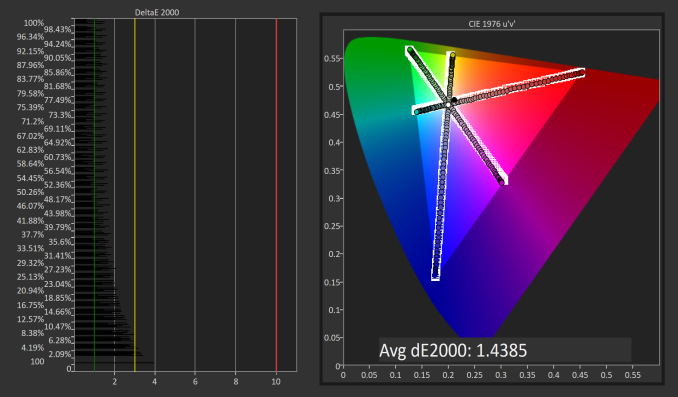
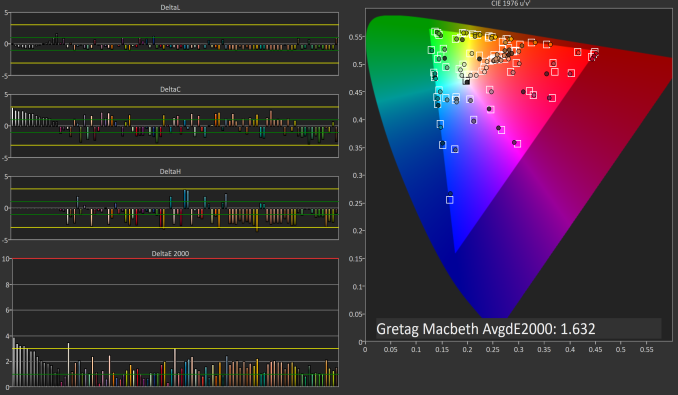








91 Comments
View All Comments
imaheadcase - Tuesday, October 2, 2018 - link
3840x1600 is the dell i mean.Impulses - Tuesday, October 2, 2018 - link
The Acer Predator 32" has a similar panel as that BenQ and adds G-Sync tho still at a max 60Hz, not as well calibrated out of the box (and with a worse stand and controls) but it has dropped in price a couple times to the same as the BenQ... I've been cross shopping them for a while because 2 grand for a display whose features I may or may not be able to leverage in the next 3 years seems dubious.I wanted to go 32" too because the 27" 1440p doesn't seem like enough of a jump from my 24" 1920x1200 (being 16:10 it's nearly as tall as the 16:9 27"erd), and I had three of those which we occasionally used in Eyefinity mode (making a ~40" display). I've looked at 40-43" displays but they're all lacking compared to the smaller stuff (newer ones are all VA too, mostly Phillips and one Dell).
I use my PC for photo editing as much as PC gaming but I'm not a pro so a decent IPS screen that I can calibrate reasonably well would satisfy my photo needs.
Fallen Kell - Tuesday, October 2, 2018 - link
It is "almost" perfect. It is missing one of the most important things, HDMI 2.1, which has the bandwidth to actually feed the panel with what it is capable of doing (i.e. 4k HDR 4:4:4 120Hz). But we don't have that because this monitor was actually designed 3 years ago and only now finally coming to market, 6 months after HDMI 2.1 was released.lilkwarrior - Monday, October 8, 2018 - link
HDMI 2.1 certification is still not done; it would not have been able to call itself a HDMI 2.1 till probably late this year or next year.imaheadcase - Tuesday, October 2, 2018 - link
The 35 inch one has been canceled fyi. Asus rep told me when inquired about it just a week ago, unless in a week something has changed. Reason being panel is not perfect yet to mass produce.That said, its not a big loss, even if disappointing. Because HDR is silly tech so you can skip this generation
EAlbaek - Tuesday, October 2, 2018 - link
I bought one of these, just as they came out. Amazing display performance, but the in-built fan to cool the G-Sync HDR-module killed it for me.It's one of those noisy 40mm fans, which were otherwise banned from PC setups over a decade ago. It made more noise than the entirety of the rest of my 1080 Ti-SLI system combined. Like a wasp was loose in my room all the time. Completely unbearable to listen to.
I tried to return the monitor as RMA, as I thought that couldn't be right. But it could, said the retailer. At which point I chose to simply return the unit.
In my case, these things will have to wait, till nVidia makes a new G-Sync HDR module, which doesn't require active cooling. Plain and simple. I'm sort of guessing that'll fall in line with the availability of micro-LED displays. Which will hopefully also be much cheaper, than the ridiculously expensive FALD-panels in these monitors.
imaheadcase - Tuesday, October 2, 2018 - link
Can't you just replace the fan yourself? I read around the time of release someone simply removed fan and put own silent version on it.EAlbaek - Tuesday, October 2, 2018 - link
No idea - I shouldn't have to void the warranty on my $2000 monitor, to replace a 40mm fan.madwolfa - Tuesday, October 2, 2018 - link
Is that G-Sync HDR that requires active cooling or FALD array?EAlbaek - Tuesday, October 2, 2018 - link
It's the G-Sync HDR chip, apparantly.